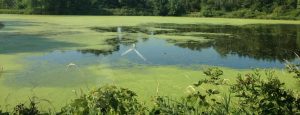Prairie Rivers Network recently attended the kickoff meeting of the Illinois State Nutrient Reduction Strategy. The Illinois Environmental Protection Agency and Department of Agriculture announced they will be writing a state plan to reduce nutrient pollution. The plan is being written because Illinois is one of the leading contributors of nitrogen and phosphorus pollution that causes the annual Dead Zone in the Gulf of Mexico. Not only does Illinois export nutrients, but there are plenty of nutrient-impaired waters within the state.

The plan will address both point and non-point sources of nutrient pollution. It is essential that pollution reductions come from both sectors to achieve meaningful progress towards clean water. The federal Clean Water Act gives Illinois EPA the authority to regulate and reduce discharges from point sources such as sewage treatment plants. Illinois could be doing more with this existing authority, and should because point sources can have very detrimental impacts and are a significant part of the problem. Nutrient removal technologies are available but point sources are slow to adopt them because of the expense. However, progress is being made plant by plant.
The majority of nutrient pollution comes from agriculture, which is exempt from the Clean Water Act (with the exception of certain livestock operations). As a society, we have relied for decades on voluntary measures to reduce pollution from agriculture. In other words, farmers have taken steps on their own, or society has financially incentivized farmers’ adoption of practices that will reduce the loss of agricultural chemicals from farm fields. Unfortunately, the voluntary approach is both expensive to taxpayers and insufficient, as agriculture remains a leading source of water pollution.
There may be certain land management practices that should be required or prohibited that would make significant improvements in the quality of Illinois’ rivers. We need to come up with solutions that are beneficial to both the health of farms and the environment. Conceptually, farmers and environmentalists should not be that far apart on this matter because nutrient pollution represents a loss of income to farmers. However, we disagree on the effectiveness of a strictly voluntary approach, and therefore Prairie Rivers Network is looking for new approaches that include more farmer accountability and faster progress.
While attending the kickoff meeting, we asked whether the agricultural section of Illinois’ State Nutrient Reduction Strategy would include more than voluntary measures. Unfortunately, voluntary is the plan for now. Dissatisfied with this answer, Prairie Rivers Network wrote House Bill 2034, which would require Illinois EPA to assemble a diverse stakeholder taskforce to assess and recommend regulatory options to reduce pollution from agriculture. The bill was introduced late in the session and unfortunately it has stalled due to legislative deadlines.
Regardless of what happens with the bill, we hope it will inspire thoughtful and serious discussions at the upcoming Nutrient Reduction Strategy policy meetings. We will be at those meetings, advocating for programs and practices with proven ability to make a difference.







